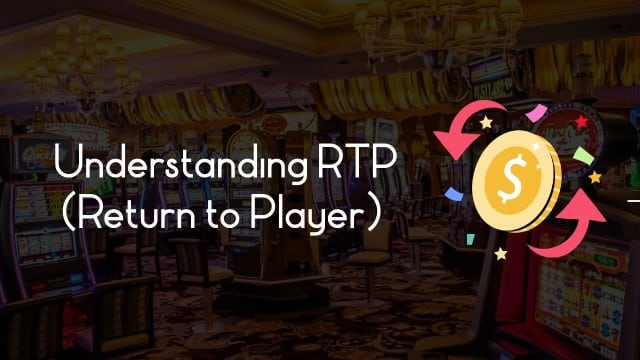Understanding RTP (Return to Player) in Online Casinos: An In-Depth Guide

In this guide, we will explore an abbreviation that often goes unnoticed by many casino players. What exactly does ‘RTP’ mean, and why should it matter to you?
If you enjoy the thrill of casino games, such as pokies or other online casino games, it is crucial to comprehend the meaning of RTP — the Return To Player — and why the percentage fluctuates from game to game. Closely related, it is also important to grasp the concept of game variance also known as volatility.
Read on to find out more about the RTP rate. This guide is tailored to New Zealand online pokie enthusiasts.
Table of Contents
What Does RTP Stand For in Casino Games?
RTP is short for Return to Player which basically means what it says it means: is stands for the return to the player of a casino game. The RTP, however, comes in a percentage which represents the money that will be paid back to the player over time. The RTP is a long-term average and does not provide a guaranteed outcome. Instead it is often used as a close estimation of payouts. Online casinos and game developers include the RTP to give the player a better idea of their chances of winning. Whilst RTP is a factor that influences a game’s profitability for a casino, it is not the only criterion that is used by stakeholders. Below, we will dive into the variance of casino games.
Variance/Volatility
Volatility (also known as variance) is another percentage indicating how frequently a specific casino game leads to a payout. Although volatility and RTP are closely interrelated, the volatility of a casino game can’t be predicted based on its RTP. At the same time, the opposite is also true which means that the RTP doesn’t say anything about the variance. Just to clarify our point here: casino games with the same RTP may have different payout patterns, which on their turn depend on the game’s level of volatility or variability.
Low vs. high variance
This explains why a casino game with a low volatility generally leads to frequent winning combinations, although these tend to represent smaller amounts od money. A high-volatility game pays out less often but offers larger prizes when you do win. Online pokies with a high RTP and a low variance give the player frequent payouts, albeit with smaller prizes. The upside about this is that it keeps the game engaging. On the other hand, a pokie with high RTP and high volatility pays out less frequently but offers more significant rewards.
What is (Winning) Hit Frequency?
This number shows how often a game leads to a winning combination. A casino game (such as a free pokie game) with a (winning) hit frequency of 18% will produce winning combinations approximately 18% of the spins made. Do bear in mind that online pokies have multiple pay lines, and you may be winning on one pay line whilst losing on others. Whilst a game may have a high hit frequency, the winnings may not be so high in monetary values. It is, however, a useful number if you want to get the clear picture.
How to Calculate RTP In Games?
In order to calculate the RTP in a casino game, you will need to use the following formula:
- RTP = money paid out / total amount of money wagered.
At first sight, this may seem simple, but it is important to know that the data for this calculation is not readily available to everyone. Game developers go through thousands of game simulations with the sole goal to collect the data and announce a game’s RTP. Although you cannot access these numbers yourself, several methods exist to determine the RTP of a pokie game. To understand this better, let’s delve into the basics of how pokies work.
Online pokies are essentially games driven by a Random Number Generator (RNG). While each spin is said to be fully random, the average return to player value can be determined over time. This preset value does not change, but the actual payouts may deviate from the advertised values. As the number of plays increases, the RTP will get closer to the percentage as provided by the game developer. For instance, an online pokie that has been played 1,000,000x will typically deviate by approximately 1% from the mean.
RTP of Casino Games
RTP can help in determining the odds in pure games of chances like online pokies. For other casino games this applies to a much lesser extent, as table games like poker, blackjack, or baccarat are also based on someone’s skills. Below, we have come up with an overview of different popular casinos games that can also be played online:
| Blackjack | 99.43% |
| Roulette | 97.3% |
| Punto Banco | 99.07% |
| Online Pokies | Approximately 96% |
| Lotteries | Between 35% and 65% |
| Online Scratch Cards | 95% |
Pokie games with the highest RTP, on the other hand, often come with low volatility. While these games do provide a high level of entertainment and fun, huge payouts should not be expected. Additionally, online pokie games often offer demo versions that can be advantageous. Play the demo version to familiarise yourself with the game’s features and understand its RTP and variance. If the prizes are frequent yet unremarkable, it indicates a game with low variance. Conversely, if a substantial jackpot is at stake, it is likely a game with higher volatility.
Games like poker and baccarat require skills. Hence, the actual payout and the designed RTP of these games differ not due to the number of spins played (as is the case with online pokies), but because players may play their hands better or worse. This also means that you can’t rely on RTP for these games like with online pokies. RTP is usually seen as a useful indicator for slot games as these are based on randomness and don’t require skills.
Online vs. Land-based Casino RTP
The RTP is a helpful percentage in order to make you choose the right game and even the right casino site as some work with multiple RTP (more on that below). There is a wide variety of online games, which why it shouldn’t be too much of a challenge finding online casino games with low volatility and/or high RTP rates. Here are some common RTP rates for different type of casino venues:
- The RTP for a brick-and-mortar casino venue is usually topped at 92%; lower percentages are considered normal in offline settings.
- Online pokies generally offer higher win percentages, with RTPs below 94% considered low in the industry.
- An RTP ranging between 96% and 97% is considered very common for online pokies with 96% being the absolute average.
- Some casino games even boast RTPs as high as 98% or 99% with newer games like Book of 99 proving that game developers still value fair chances of winning.
Higher RTP’s generally serve as an indicator of a game’s profitability although they are technically different.
Final Note: Ranging RTP
In order to cater to the demands of the ever-changing online casino market, game developers have adopted a flexible approach, offering online versions of the same game with varying Return to Player (RTP) percentages, such as 96%, 94%, 91%, and 88%. This gives real-money online casinos the flexibility to provide casino games with an RTP they consider fair while it gives them enough income at the same time. However, players must exercise caution and follow the steps outlined in this comprehensive guide on how to discover the RTP of pokies. It is crucial to select casinos that offer the highest odds of winning to maximize the value of real-money bets.
It is important to note that finding the RTP of a casino game can greatly benefit your overall casino experience, particularly if you are a frequent player. Similar to considering factors like volatility, game theme, or potential maximum win, seeking out games that meet your desired RTP criteria should be a fundamental aspect of your selection process. Our aim is to assist you in finding pokie games that satisfy all your requirements, including a favorable Return to Player percentage. However, it is essential to remember that this specification only provides insight into the theoretical outcome of your spins over an extended period, assuming a large number of bets. In the short term, anything is possible, and outcomes may deviate from statistical expectations.






